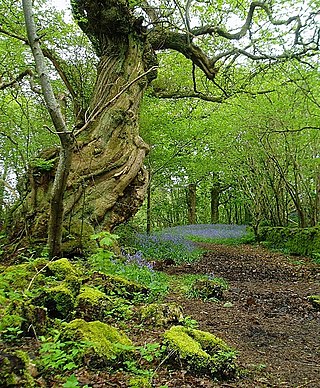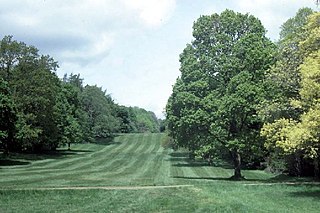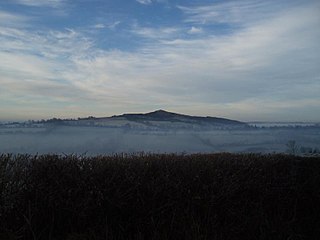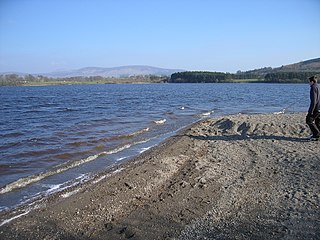
The Woodland Trust is the largest woodland conservation charity in the United Kingdom and is concerned with the creation, protection, and restoration of native woodland heritage. It has planted over 50 million trees since 1972.

In the United Kingdom, an ancient woodland is a woodland that has existed continuously since 1600 or before in England, Wales and Northern Ireland. Planting of woodland was uncommon before those dates, so a wood present in 1600 is likely to have developed naturally.

Russborough House is a stately house near the Blessington Lakes in County Wicklow, Republic of Ireland. Located between the towns of Blessington and Ballymore Eustace, it is an outstanding example of Palladian architecture, designed by Richard Cassels for Joseph Leeson, 1st Earl of Milltown and built between 1741 and 1755. With a frontage measuring 210 m (690 ft), it may be the longest house in Ireland. The interior contains fine ornate plasterwork on the ceilings by the Lafranchini brothers, who also collaborated with Castle on Carton House. Russborough contains an important private collection of European fine and decorative arts, including furniture, silver, porcelain and paintings.

Blessington, historically known as Ballycomeen, is a town on the River Liffey in County Wicklow, Ireland, near the border with County Kildare. It is around 25 km south-west of Dublin, and is situated on the N81 road, which connects Dublin to Tullow.

Highgate Wood is a 28 hectare area of ancient woodland in North London, lying between East Finchley, Highgate and Muswell Hill. It was originally part of the ancient Forest of Middlesex which covered much of London, Hertfordshire and Essex and was mentioned in the Domesday Book. It lies in the London Borough of Haringey, but is owned and managed by the City of London Corporation.

Queen's Wood is a 52-acre area of ancient woodland in the London Borough of Haringey, abutting Highgate Wood and lying between East Finchley, Highgate, Muswell Hill and Crouch End. It was originally part of the ancient Forest of Middlesex which covered much of London, Hertfordshire and Essex and was mentioned in the Domesday Book. It is now one of three Local Nature Reserves in the London Borough of Haringey. It is situated a few minutes' walk from Highgate tube station.

Hatfield Forest is a 403.2-hectare (996-acre) biological Site of Special Scientific Interest in Essex, three miles east of Bishop's Stortford. It is also a National Nature Reserve and a Nature Conservation Review site. It is owned and managed by the National Trust. A medieval warren in the forest is a Scheduled Monument.

Great Breach and Copley Woods is a 64.8 hectare biological Site of Special Scientific Interest 1 km south of Compton Dundon and 5 km south-east of Street in Somerset, England, notified in 1972.

Sir Alfred Lane Beit, 2nd Baronet was a British Conservative Party politician, art collector and philanthropist and honorary Irish citizen.

Avondale Forest is a wooded estate in County Wicklow, Ireland, on the west bank of the River Avonmore. It contains the home of Charles Stewart Parnell which was built in 1777 by Samuel Hayes and is now the Parnell Museum. The park is rich in wildlife and notable features include the exotic tree trail and a well-developed arboretum.

Knockeyon is a hill in County Westmeath, Ireland in the townland of Streamstown. When viewed from the Ranaghan, and Gillardstown side of the hill, it dominates the surrounding lakes in the countryside of northern County Westmeath. The chimney of the cement works in Duleek near Drogheda can be seen on a clear day due west, as well as Slieve Gullion in South Armagh and the Mourne Mountains beyond to the north east. The Hills of Mael, Curry and Mullaghmean are viewed from Knockeyon to the north west, and the Cuilcagh Mountains to the north-north-west.

Poulaphouca Reservoir, officially Pollaphuca, is an active reservoir and area of wild bird conservation in west County Wicklow, Ireland named after the Poulaphouca waterfall on its south-western end where the water exits the lake. The lake is also commonly known as the Blessington Lakes, even though there is just one.

Bowdown and Chamberhouse Woods is a 67.9-hectare (168-acre) biological Site of Special Scientific Interest south of Thatcham in Berkshire. An area of 55 hectares is a nature reserve managed by the Berkshire, Buckinghamshire and Oxfordshire Wildlife Trust.

Bedford Purlieus is a 211-hectare (520-acre) ancient woodland in Cambridgeshire, in the United Kingdom. It is a national nature reserve and Site of Special Scientific Interest owned and managed by the Forestry Commission. In Thornhaugh civil parish, 10 km (6.2 mi) south of Stamford and 14 km (8.7 mi) west of Peterborough, the wood is within the Peterborough unitary authority area of Cambridgeshire, and borders Northamptonshire. In Roman times it was an iron smelting centre, during the medieval period it was in the Royal Forest of Rockingham, and later it became part of the estates of the Duke of Bedford. Bedford Purlieus appears to have been continuously wooded at least from Roman times, and probably since the ice receded. The woodland may have the richest range of vascular plants of any English lowland wood. It acquired particular significance in the 1970s as an early subject for the historical approach to ecology and woodland management.
Heartwood Forest is a planned forest in Hertfordshire, England. The site covers 347 hectares, the largest continuous new native forest in England.

The Clyde Valley Woodlands National Nature Reserve (NNR) comprises six separate woodland sites in the Clyde Valley region of South Lanarkshire, Scotland. These six sites are located along a 12 km section of the River Clyde and its tributaries, and lie close to built-up areas such as Hamilton and Lanark on the southern outskirts of Greater Glasgow. The sites can be easily accessed by about two million people living in the surrounding urban areas, making the reserve unique amongst Scotland's NNRs, most of which tend to be located in more remote areas. The six sites are:

Bull Cross, The Frith and Juniper Hill is a 42.33-hectare (104.6-acre) biological and geological Site of Special Scientific Interest in Gloucestershire, notified in 1954. The site is listed in the ‘Stroud District’ Local Plan, adopted November 2005, Appendix 6 as an SSSI and Regionally Important Geological Site (RIGS).

The Central Gardens Nature Reserve, also called Central Gardens, is a protected nature reserve located in the western suburbs of Sydney, New South Wales, Australia. Established in 1976, the 12-hectare (30-acre) reserve, garden and fauna and wildlife park is situated in the suburb of Merrylands and is managed by Cumberland Council. The park is regionally important and it attracts visitors outside the Cumberland local government area. The bushland contains remnants of Cumberland Plain Woodland and is approximately 3.5 hectares.

Duncliffe Wood is an ancient woodland on the summit of Duncliffe Hill, a few miles west of Shaftesbury. The area of the site is 92.16 hectares, making it one of the largest ancient woodlands in North Dorset.
The Glencullen River, often the Cookstown River below Enniskerry, is a watercourse of Dún Laoghaire–Rathdown and northern County Wicklow. About 11 kilometres (6.8 mi) long; it passes the nature reserve of Knocksink Wood and the village of Enniskerry, and joins the River Dargle near Bray. The river is in the jurisdictions of Dún Laoghaire–Rathdown and Wicklow County Councils, as well as within the purview of the Environmental Protection Agency.




















